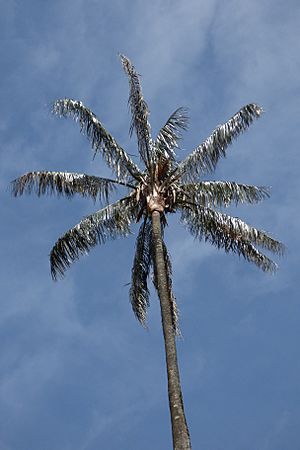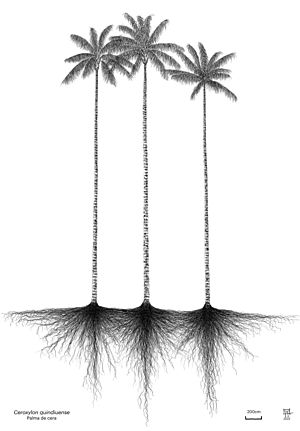Ceroxylon quindiuense facts for kids
Quick facts for kids Ceroxylon quindiuense |
|
|---|---|
 |
|
| At Armenia, Colombia. | |
| Conservation status | |
| Scientific classification | |
| Genus: |
Ceroxylon
|
| Species: |
quindiuense
|
| Synonyms | |
|
|
The Ceroxylon quindiuense, also known as the Quindío wax palm, is a very tall palm that grows in the mountains. It is found in the wet forests of the Andes in Colombia and Peru. This amazing tree is the national tree of Colombia.
Contents
About the Quindío Wax Palm
This special palm tree can grow very tall. It often reaches heights of 45 meters (about 148 feet). Sometimes, it can even grow as tall as 60 meters (about 197 feet)! This makes it the tallest type of monocot plant in the world. Monocots are a group of flowering plants that have one seed leaf.
The trunk of the palm is smooth and light-colored. It is covered with a layer of wax. You can see dark rings around the trunk where old leaves used to be. The leaves are dark green and grayish. They can be very long, from 1.85 to 5.4 meters (6 to 18 feet). The fruits are round and turn orange-red when they are ripe. They are about 1.6 to 2 centimeters (0.6 to 0.8 inches) wide.
Where It Lives
The Quindío wax palm grows in large groups. You can find many of them in the central and eastern parts of the Andes mountains in Colombia. They are also found in northern Peru. These palms grow at high elevations, usually between 2,000 and 3,100 meters (6,560 to 10,170 feet) above sea level.
These palms start to produce seeds when they are about 80 years old. They provide homes for many different animals. This includes endangered species like the yellow-eared parrot (Ognorhynchus icterotis).
Names for the Palm
In Colombia, people call this palm "Palma de cera" or "Palma de ramo." Both names mean "wax palm" or "branch palm."
Protecting the Palm
The Quindío wax palm faces several dangers. Its natural home is being disturbed. People have also collected too many of its fruits and leaves. Diseases can also harm the palms.
In the past, the fruits were used to feed cows and pigs. The leaves were also widely used for Palm Sunday celebrations by Catholics. People would often cut leaves from young palms, which sometimes killed the trees. Luckily, this practice has been greatly reduced. This is thanks to new laws and public awareness campaigns.
Some people still cut down these palms to get wax from their trunks. This happens in Colombia and Peru. However, the Quindío wax palm is very important to Colombia. It was made the national tree of Colombia in 1985. Since then, it has been a legally protected species in the country.
Uses of the Palm
The wax from the trunk of the palm was used to make candles. This was especially common in the 1800s. The strong outer part of the palm's stem has been used by local people to build houses. It was also used to create water systems for farmers. Today, the Quindío wax palm is also grown as a beautiful plant in gardens in Colombia and California.
Gallery
See also
 In Spanish: Palma de Cera del Quindío para niños
In Spanish: Palma de Cera del Quindío para niños










